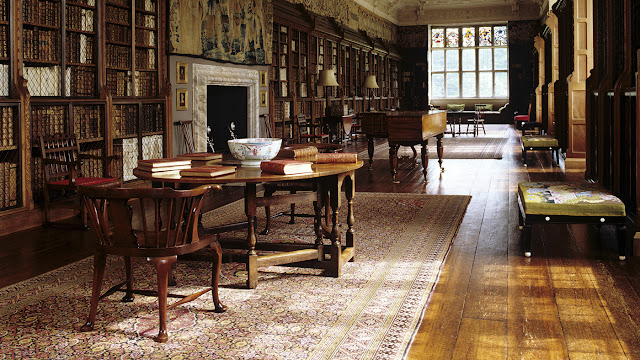Blickling Hall, Norfolk © National Trust
Thursday, 1st May, 1947
"It is May Day and pouring and blowing icily. Stopped at Cawston church to gaze my fill at the fourteenth-century roof and painted panels of saints on the screen. At Blickling made my peace with the caretakers and Miss O'Sullivan who is always nice to me. Alec* came over and had some useful suggestions for arranging furniture. The rooms now filled do not look any more beautiful because the furniture is on the whole poor. The house was today open for the first time, and only twenty people came. So we need not have fussed ourselves." (*Alexander Penrose)
Caves of Ice James Lees-Milne, 1947
Blickling Hall (built 1616) was one of Lees-Milne's favourite houses, although when he visited in May 1942 the RAF were occupying the house, not without causing some damage, and a sea of Nissen huts was in the grounds. In 1984 he met the teenage actors who were performing a play to celebrate the National Trust's acquisition of Blickling from Philip Kerr, 11th Marquess of Lothian, in 1941. "I am apparently the only person left who remembers Lord Lothian, [Donald] Matheson and the place in pre-war days."
Although few people would have recognised it, Blickling Hall was seen in cinemas across England in 1945 and 46 when its exterior was used to represent "Maryiot Cells", the Buckinghamshire home of scandalous "Lady Skelton". This was Margaret Lockwood's iconic film with James Mason, The Wicked Lady, in which the heroine sheds corsets and morals and turns highwayman herself. Audiences both sides of the Atlantic were shocked and enthralled by their favourite stars in this period drama.
Gainsborough Film Studio poster c. 1945
Publicity film still for "The Wicked Lady" (*from a story by Magdalen King-Hall)
with Margaret Lockwood and James Mason
with Margaret Lockwood and James Mason
A more famous and charismatic lady associated with Blickling Hall is Anne Boleyn, as it was the home of her father Sir Thomas Boleyn, and Anne is thought to have been born there (around 1504) although at that period Blickling Hall was still a moated late-medieval manor house.
Drawing of Queen Anne by Hans Holbein, © Royal Collection
Most of the contemporary portraits of Anne were destroyed after her death, and the accuracy of later paintings is open to doubt. This miniature portrait was in the collection of Horace Walpole, at Strawberry Hill, when it was thought to represent Queen Katharine of Aragon.
Possibly Anne Boleyn, c. 1532-3 Lucas Hornbout
© 9th Duke of Buccleuch Trust
Returning to her childhood home, Anne is believed to haunt Blickling on May 19th, the date of her execution in 1536, carrying her bloody head with her. She is driven, it is said, in a coach with flaming headless horses and driver; meanwhile, her over-ambitious father, Thomas Boleyn, later himself executed for his political scheming, is condemned on the same night to cross a dozen bridges before cockcrow, driving from Blickling to Wroxham, every year for a thousand years.
View of the South Front Entrance © National Trust
Blickling is also famous for its Library, the collection of Sir Richard Ellys, which was brought to the House in 1740. Among its 12,500 volumes are sure to be histories of the House and Estate, its famous occupants, and its ghosts.
Today the gardens at Blickling are as beautiful as the house:
The Library in the Long Gallery at Blickling
© National Trust
Today the gardens at Blickling are as beautiful as the house:
"The first sight of the entrance front from the public road is so famous and breathtaking that every passing motorist halts instinctively to take a longer look. But the secret of the place is only discovered late in the day among the trees and flowering shrubs that stretch upwards from the east side of the house. Never has there been a garden quite like it, not at least since the eighteenth century,…Great arches of beech and oak form choirs and aisles, and under them grow azaleas, rhododendron, magnolias and wild bluebell." Nigel Nicolson, 1978



















